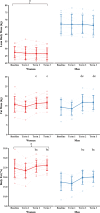Sex differences in energy balance, body composition, and metabolic and endocrine markers during prolonged arduous military training
- PMID: 38385180
- PMCID: PMC11305646
- DOI: 10.1152/japplphysiol.00864.2023
Sex differences in energy balance, body composition, and metabolic and endocrine markers during prolonged arduous military training
Abstract
This study investigated sex differences in energy balance, body composition, and metabolic and endocrine markers during prolonged military training. Twenty-three trainees (14 women) completed 44-wk military training (three terms of 14 wk with 2-wk adventurous training). Dietary intake and total energy expenditure were measured over 10 days during each term by weighed food and doubly labeled water. Body composition was measured by dual-energy X-ray absorptiometry (DXA) at baseline and at the end of each term. Circulating metabolic and endocrine markers were measured at baseline and at the end of terms 2 and 3. Absolute energy intake and total energy expenditure were higher, and energy balance was lower, for men than women (P ≤ 0.008). Absolute energy intake and balance were lower, and total energy expenditure was higher, during term 2 than terms 1 and 3 (P < 0.001). Lean mass did not change with training (P = 0.081). Fat mass and body fat increased from term 1 to terms 2 and 3 (P ≤ 0.045). Leptin increased from baseline to terms 2 and 3 in women (P ≤ 0.002) but not in men (P ≥ 0.251). Testosterone and free androgen index increased from baseline to term 3 (P ≤ 0.018). Free thyroxine (T4) decreased and thyroid-stimulating hormone (TSH) increased from baseline to term 2 and term 3 (P ≤ 0.031). Cortisol decreased from baseline to term 3 (P = 0.030). IGF-I and total triiodothyronine (T3) did not change with training (P ≥ 0.148). Men experienced greater energy deficits than women during military training due to higher total energy expenditure.NEW & NOTEWORTHY Energy deficits are common in military training and can result in endocrine and metabolic disturbances. This study provides first investigation of sex differences in energy balance, body composition, and endocrine and metabolic markers in response to prolonged and arduous military training. Men experienced greater energy deficits than women due to higher energy expenditure, which was not compensated for by increased energy intake. These energy deficits were not associated with decreases in fat or lean mass or metabolic or endocrine function.
Keywords: body composition; musculoskeletal injury; nutrition; performance.
Conflict of interest statement
No conflicts of interest, financial or otherwise, are declared by the authors.
Figures






Similar articles
-
Sex differences in body composition and serum metabolome responses to sustained, physical training suggest enhanced fat oxidation in women compared with men.Physiol Genomics. 2023 May 1;55(5):235-247. doi: 10.1152/physiolgenomics.00180.2022. Epub 2023 Apr 3. Physiol Genomics. 2023. PMID: 37012051 Free PMC article.
-
Effects of dietary protein content on IGF-I, testosterone, and body composition during 8 days of severe energy deficit and arduous physical activity.J Appl Physiol (1985). 2008 Jul;105(1):58-64. doi: 10.1152/japplphysiol.00005.2008. Epub 2008 May 1. J Appl Physiol (1985). 2008. PMID: 18450989 Clinical Trial.
-
Negative energy balance in male and female rangers: effects of 7 d of sustained exercise and food deprivation.Am J Clin Nutr. 2006 May;83(5):1068-75. doi: 10.1093/ajcn/83.5.1068. Am J Clin Nutr. 2006. PMID: 16685048
-
Gender differences in insulin resistance, body composition, and energy balance.Gend Med. 2009;6 Suppl 1(Suppl 1):60-75. doi: 10.1016/j.genm.2009.02.002. Gend Med. 2009. PMID: 19318219 Free PMC article. Review.
-
Energy Deficiency in Soldiers: The Risk of the Athlete Triad and Relative Energy Deficiency in Sport Syndromes in the Military.Front Nutr. 2020 Aug 25;7:142. doi: 10.3389/fnut.2020.00142. eCollection 2020. Front Nutr. 2020. PMID: 32984399 Free PMC article. Review.
Cited by
-
Resting metabolic rate and energy efficiency in response to an intensive 84-day combat-swimmer training in the German Armed Forces.Eur J Appl Physiol. 2025 Apr;125(4):1101-1114. doi: 10.1007/s00421-024-05659-0. Epub 2024 Nov 25. Eur J Appl Physiol. 2025. PMID: 39586886 Free PMC article.
-
Body weight regulation models in humans: insights for testing their validity.Nat Rev Endocrinol. 2025 Jul 24. doi: 10.1038/s41574-025-01149-1. Online ahead of print. Nat Rev Endocrinol. 2025. PMID: 40707700 Review.
-
Impact of Stress on Adrenal and Neuroendocrine Responses, Body Composition, and Physical Performance Amongst Women in Demanding Tactical Occupations: A Scoping Review.Metabolites. 2025 Jul 29;15(8):506. doi: 10.3390/metabo15080506. Metabolites. 2025. PMID: 40863125 Free PMC article. Review.
References
MeSH terms
Grants and funding
LinkOut - more resources
Full Text Sources
Medical

